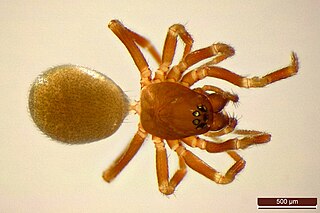
Linyphiidae, spiders commonly known as sheet weavers, or money spiders is a family of very small spiders comprising 4706 described species in 620 genera worldwide. This makes Linyphiidae the second largest family of spiders after the Salticidae. The family is poorly understood due to their small body size and wide distribution, new genera and species are still being discovered throughout the world. The newest such genus is Himalafurca from Nepal, formally described in April 2021 by Tanasevitch. Since it is so difficult to identify such tiny spiders, there are regular changes in taxonomy as species are combined or divided.

Enoplognatha is a genus of comb-footed spiders that was first described by P. Pavesi in 1880. They have both a large colulus and a subspherical abdomen. Males usually have enlarged chelicerae. It is considered a senior synonym of Symopagia.

Erigone is a genus of dwarf spiders that was first described by Jean Victoire Audouin in 1826. They are carnivorous, preying on small insects such as psylla and flies. One of the distinctive characters for this genus is the presence of teeth bordering the carapace.

Lepthyphantes is a genus of dwarf spiders that was first described by Anton Menge in 1866.

Tenuiphantes is a genus of sheet weavers that was first described by Michael I. Saaristo & A. V. Tanasevitch in 1996.

Bathyphantes is a genus of dwarf spiders that was first described by Anton Menge in 1866.

Agyneta is a genus of dwarf spiders that was first described by J. E. Hull in 1911.
Scotinotylus is a genus of sheet weavers that was first described by Eugène Louis Simon in 1884.

Robertus is a genus of comb-footed spiders that was first described by Octavius Pickard-Cambridge in 1879. It is considered a senior synonym of Garritus.

Haplodrassus is a genus of ground spiders that was first described by R. V. Chamberlin in 1922. They range from 3 to 10 millimetres. H. signifer is the most widespread species, found across North America except for Alaska and northern Canada.

Centromerus is a genus of dwarf spiders that was first described by David B. Hirst in 1886.
Hilaira is a genus of dwarf spiders that was first described by Eugène Louis Simon in 1884.

Pelecopsis is a genus of dwarf spiders that was first described by Eugène Louis Simon in 1864.
Porrhomma is a genus of sheet weavers that was first described by Eugène Louis Simon in 1884.

Tapinocyba is a genus of sheet weavers that was first described by Eugène Louis Simon in 1884.
Collinsia is a genus of dwarf spiders that was first described by Octavius Pickard-Cambridge in 1913.












